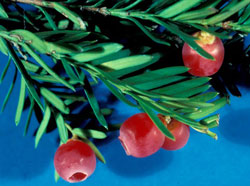Resource Library
Plant of the Week: Poisonous Plants
The University of Arkansas System Division of Agriculture does not promote, support or recommend plants featured in "Plant of the Week." Please consult your local Extension office for plants suitable for your region.
Plant of the Week
Poisonous Plants

It's a big, scary, complicated world to out there to navigate. On the Web, there are plenty of accounts of poisonous plants, often with detailed technical jargon, but usually with little real world perspective. Sure, plants can kill, but it is a very rare thing.
How many poisonous plants are there?
It has been estimated that one-third of the plants in the world contain some toxic components. These toxins have an important role in nature, at least to the plant, by protecting against foliage feeding by insects or grazing animals. The list of toxic plants includes oaks, hollies, azaleas, yews, cherries, almost all the flower bulbs, and a host of others. Even lots of food plants make the list of toxic plants including potatoes, peaches, apples, rhubarb and even broccoli - should you be a cow.
List of common poisonous plants
What is meant by the term "poisonous"?
Even the term "poisonous plant" is misleading. Remember, this is an umbrella term used to describe everything from a skin rash from poison ivy to diarrhea from eating too many green apples. Poisonous and fatal are not synonyms. Lots of casual contacts with poisonous plants are reported, but are well below the threshold level required to do significant harm.
The dosage effect is a well-understood part of our everyday life. While it is true apples are technically poisonous, it is only the seeds that contain the toxic component. Most of us don't eat the apple core so this isn't a problem. But should you do something unusual like save your apple seeds and thoroughly chew them before swallowing, you could have a problem.
Who (or what) is likely to actually be poisoned by a plant?
Yews are quite poisonous but because we are not herbivores, the likelihood of accidentally consuming a lethal dose of foliage is improbable. Cows, on the other hand, are herbivores and I've read of cattle losses by discarding yew hedge trimmings into the pasture where cattle were grazing. In England in the last decade, there have been at least two cases where depressed individuals used Taxus as their drug of choice instead of some toxic drug from the corner pharmacy.
Poisonous houseplants
Toddlers and pets should not be trusted around houseplants that find their way onto a poisonous plant list. It only makes sense that Dieffenbachia, Oleander and open pills be kept out of the reach of the reach of exploring children. But, while there are thousands of calls to poison control centers about accidental plant exposure by children younger than 5, the number of fatalities is zero.
As children grow old enough to move outside into the backyard for play, they should be taught never to eat the berries they might find growing there. The likelihood of their digging a daffodil bulb and munching on it is low, but even if they did, the odds of consuming enough to reach a threshold level or injury is remote.
The age group of male 13-to 19-year-olds - are responsible for most serious cases of plant poisonings. Experimentation with drug plants - some of which grow in the garden - too often ends with a trip to the emergency room. The plant related fatalities that are reported through the poison control network almost exclusively involve this kind of drug related experimentation.
By: Gerald Klingaman, retired
Extension Horticulturist - Ornamentals
Extension News - November 20, 2009